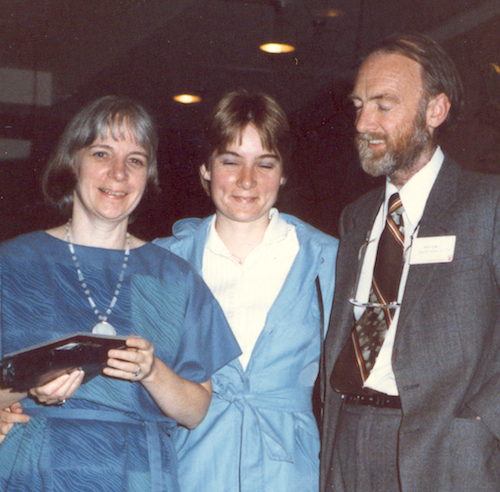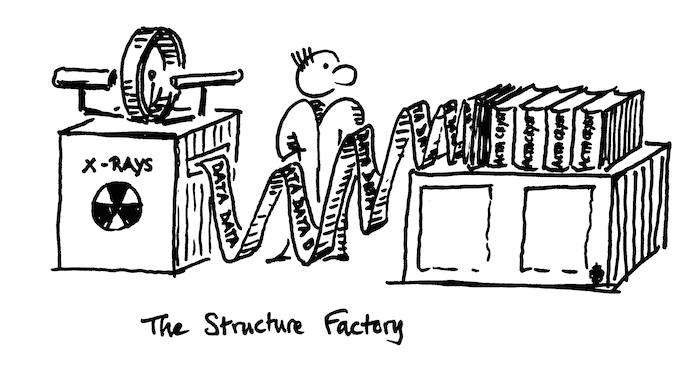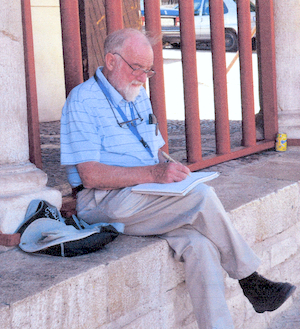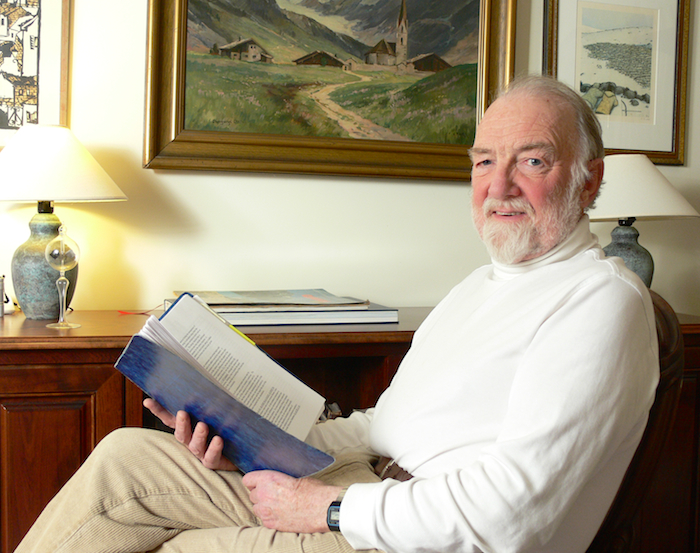- History Home
- People, Leadership & Service
- A Legacy of Excellence
- History & Impact
- Meetings Through the Years
- Resources
Memoir - I. David BrownMemoir | Publications | Curriculum Vitae | Videos | Slides | Articles | Obituary
ACA Living History2016
At the age of ten I had a chemistry set and puzzled over the meaning of the chemical formulae. My grandfather was the director of a large industrial research laboratory, and served as my role model, and while we both enjoyed science I inherited neither his energy nor his administrative abilities. Unfortunately he died when I was only 16. It was around this time that I was given a Periodic Table which included the quantum numbers of the different atoms. The family had many physicist friends who did their best to explain quantum mechanics to me but to no avail. At King's College, London I studied physics and chemistry. The publication of Coulson's book Valence [1], which was required reading for chemists at the time, coincided with Coulson's move from King's College to Oxford, and the start of my university studies. In the Mathematics Department Professor Bondi was working on the van der Waals radii of atoms and in the Biophysics Unit Rosalind Franklin was taking x-ray diffraction photos of DNA, but as a freshman undergraduate I was unaware of most of these people. Instead, I belonged to a group of students that included Peter Higgs and Mike Fisher. I struggled to understand the theory of chemical bonding. Orbitals were newly in fashion, but I could never understand how a carbon atom decided whether to adopt sp2 or sp3 hybridization. Did it wake up in the morning and say "I feel very sp2 today, I will go and look for three atoms to bond to"? In my second year Watson and Crick published the structure of DNA and the Physics Department was on cloud nine, unaware that they had been scooped by their own measurements.
For graduate work I moved to the Royal Institution, where Lawrence Bragg was the director, and my graduate supervisor was Jack Dunitz. John Kendrew came from Cambridge bringing the first low resolution charge density map of myoglobin to show Bragg. We all gathered around, craning our necks and imaginations to convince ourselves that we could see the first experimental observation of an alpha helix. In the days before computers, solving a crystal structure was no trivial matter: few small cell structures were determined, refined and published in less than twelve months. When Jack told me "We will train you to solve crystal structures" I replied "OK, but I hope I can also contribute to the theory of chemical bonding" to which Jack replied "You don't want to go there". I read Coulson on valence and helped Jack proofread the paper in which he and Leslie Orgel introduced the Jahn-Teller theorem into solid state chemistry [2]. At the International Coordination Chemistry meeting in 1959 in London Linus Pauling entertained us with the skill of a television chef, using his hands to mix d and p orbitals into a bowlful of flavourful hybrids.
In my second graduate year Jack moved to the ETH in Zurich leaving me in the hands of David Phillips who, while always generous, was a physicist who lacked the chemical background that my project needed. In addition, my many extracurricular interests were starting to squeeze out my science. I regularly scanned the titles of the papers in each new issue of the Journal of Chemical Physics, but only now admitted to myself that I had no idea what they meant. David recommended that I cut loose from my hobbies and join Jack at the ETH where I could focus on completing my thesis under proper supervision. The timing was propitious as my funding agency was encouraging graduate students to gain experience abroad. As my thesis took shape I asked Jack where I should go for postdoctoral experience. He said "Bring me a globe, where would you like to go?" At this time the whole world was open and most new PhDs crossed the Atlantic. We had many transatlantic visitors in Zurich. Ray Pepinsky from Penn State University was spending a sabbatical in the Mineralogy Department. He would hire anyone who was prepared to sign an employment contract that kept control firmly in his hands. Gay and José Donnay gave a talk on neutron diffraction which seemed an area with a future, so when McMaster University advertised for a crystallographer to help set up neutron diffraction at its newly opened swimming pool reactor, I applied and was offered a three year fellowship.
At this time McMaster was a small Baptist university in Hamilton, Ontario with an enrollment of less than two thousand students, but it was spreading its wings under a scientific leadership ready and qualified to take full advantage of the coming university expansion. It was already well known for high resolution mass spectrometry measurements of nuclear binding energies and its future was promising. It also met the criteria for the place where I would like to settle: I could avoid the hour and a half daily commute in London, McMaster was setting high standards for scientific research, and it encouraged interdisciplinary collaboration which suited my catholic interests that extended well beyond science. I was welcomed into the faculty, where my colleagues included Bert Brockhouse, who later won a Nobel prize for his pioneering work on neutron spectroscopy, Ron Gillespie, whose VSEPR model of lone pair bonding is now taught in schools around the world, and Richard Bader whose QTAIM interpretation of charge density is familiar to all chemists. Together with my late colleague, Chris Calvo, there was an opportunity to establish a centre for both X-ray and neutron diffraction. What better place to work on the problem of chemical bonding? With luck I might find the answer to the carbon atom's dilemma.
The path behind is always clearer than the path ahead. My colleagues all seemed to know where their research was going but I was struggling to find the way. Perhaps there was no path. Even if there was a path where did it start? Our group published some neutron diffraction papers, but when I failed to solve the structures of several borates I started to question my own scientific ability. I finally solved the structure of lithium hydrazinium sulfate though I missed being scooped by a matter of only days. Two of Pepinsky's students had solved the structure some years earlier but delayed publishing for fear of breaking their contract. When they finally decided to submit their paper, it arrived on the same editor's desk shortly after mine! The two papers were eventually published back to back in Acta Crystallographica [3].
At King's College and at the Royal Institution there was pressure to move into molecular biology. It was a field with a great future, but the competition was intense and I am not competitive. I prefer to paddle gently in some neglected backwater of science where I can make progress at my own speed without the fear of being scooped. In the 1960s transition metal complexes were in fashion but few people were working on the structures of real inorganic crystals, those untainted by C-H bonds, but solving the structures of other people's crystals was leading me nowhere. Perhaps the path really did lie in molecular biology. To find out I spent a sabbatical with David Phillips, who was now running a large macromolecular group in Oxford. My job was to design a multi-film rotation camera for rapid measurement of protein diffraction patterns, but the lure of Oxford's Bodleian Library proved too strong and my interest again wandered back to history. The rotation camera was never built, but I published a book on the finds of British coin hoards [4].
David and Mariana with daughter Elizabeth at the 1986 ACA Meeting at McMaster University.
At one time I thought of a career as a librarian. I rejected this because I wanted to explore science, not merely catalogue it, but my talent for cataloguing found an outlet as an associate editor of Structure Reports, a publication that in the days before databases provided a critical compilation of the crystal structures published each year. By the late sixties it was struggling to keep up with the rapid growth in the number of crystal structures being published and it was many years out of date. My wife, Mariana, and I produced BIDICS, a Bond Index to the Determination of Inorganic Crystal Structures, which allowed recent structure determinations to be located by searching on the bonds they contained. It was simple to prepare on punch cards and quick to publish. It acted as an up-to-date stop gap, but I realised that such an index would become unmanageable after about ten years, just time, I hoped though hardly believed, to establish a computer database of inorganic crystal structures.
Shortly after my return from Oxford in1970, Bob Shannon appeared at McMaster to spend a year's leave of absence from the DuPont research laboratories. We met each other after lunch on his first day and spent the afternoon standing in the corridor talking about the bond strengths that Gay Donnay and Rudolf Allmann were using to track down elusive hydrogen atoms in crystal structures [5]. Suddenly I saw the path opening up before me. I knew that something big was about to happen, though at that stage I had no idea that it would lead me to the physical theory underlying the chemical bond. Bob and I spent the next two weeks developing the ideas and the rest of the year writing the paper [6] that showed all the things that one could do with Pauling's concept of bond strength (later called bond valence), though as happens with powerful new ideas, it took a long time before anyone else noticed. When we look at new ideas we are tempted to say "that's interesting, but I think I will stick with what I know." Converts have to discover for themselves what works, and they are only willing to try something new after everything else has failed. It took the discovery of high temperature superconductors in the 1980s for the world to discover my little backwater. Suddenly solid state inorganic chemistry was in vogue, but I was now ahead of the game and could help lead the way.
In 1975 the International Union of Crystallography Congress was held in Amsterdam in the middle of a heat wave, but in spite of the heat I needed to talk about the bond valence model to anyone who would listen. At the reception in the Rijksmuseum I met Gunter Bergerhoff and under the gaze of The Night Watch we laid plans to produce an Inorganic Crystal Structure Database [7]. We collaborated for a number of years, and the project was finally adopted by Germany with its long tradition of compiling scientific compendia. This suited me well as I had no interest in compiling the database, I only wanted to use it. I was glad to find someone else to undertake the librarian's role of assembly and management.
Unlike many universities, McMaster encourages interactions between disciplines and this was reflected in the design of our building which housed three departments with an interest in condensed matter, Geology, Chemistry and the solid state part of Physics. We all shared a single lounge. Here every morning I would meet for coffee with members of my group: graduate students, post doctoral fellows, undergraduate students in the summer, and anyone else who wanted to join us. We discussed many subjects including the projects we were working on. Sometimes we explored what we could do with bond valences and I would point out why a particular speculation could not possibly work, only to realize later that it was a winner and the source of another publication.
Any model that describes chemical structure as successfully as the bond valence model, must have some basis in physics. I looked forward to the day when Richard Bader and I would publish a paper reconciling our two very different approaches though alas this was not to be. One might have thought that chemical bonding would be the topic of many a lively discussion at McMaster, but Ron Gillespie, Richard Bader and I had three very different ideas about the meaning of the term 'chemical bond', and as we were each convinced that our own definition was without question the only true definition, dialogue was virtually impossible. I learned much from Richard, though the exchange of ideas was not reciprocal. On occasions when he had stumbled across my latest paper, he would phone me at 11 o'clock at night in a state of disbelief and say "David, what the hell is going on?" On one occasion we were discussing some scientific problem which we could not resolve, and pointing to up to the sky I said "One day when we are up there we will be able to ask Himself", to which Richard replied "Yes, but will we understand the answer?"
For several years during the nineties a group of graduate students from Prof. Trömel's laboratory in Frankfurt would spend a month in the summer with me. With Prof. Trömel's support, one of them, Christof Preiser, wrote a thesis which demonstrated that in the ionic model the bond valence was the same as the electrostatic flux that links the cations to the anions [8]. This started as one of those coffee-morning ideas that I initially dismissed out of hand before realizing that this was the Holy Grail I had been looking for. Pauling [9] and Bragg [10] had hinted at this connection before I was even born but no one had pursued it as a quantitative theory. Bond valence and flux not only had the same values, they shared another important property: neither depended on how the charge density was distributed, explaining why a century of quantum mechanical studies had failed to reveal the secrets of the traditional chemical bond. Identifying the chemical bond with the flux allows the rules of the ionic, covalent and VSEPR models all to be derived using the theorems of classical electrostatics, resulting in a simple but robust physical theory of chemical bonding that does not depend on, but yet is completely compatible with, quantum mechanics.
The crystallographer's dream, circa 1978.
Since my systematic studies of structure and bonding involved recalculating the geometry of many crystal structures, I became convinced that life would be much simpler if everyone used the same file format for recording their crystal structures. It would make moving crystallographic information between programs easier, and it would simplify the submission of crystal structure publications to the journals and databases without the need to rekeyboard all the tables of coordinates. After a couple of false starts in the 1970s, we launched CIF, where my librarian talents were again put to good use in creating CIF dictionaries [11]. This was surprisingly hard work, but the reward was a much better understanding of the concepts of crystallography.
David sketching on a break from the IUCr Congress in Madrid, 2013.
After several of my early papers were rightly rejected, I realized that the only way to convince the referees was to make sure that the evidence that supported my ideas was well documented. Crystal structure information can be downloaded from the databases, but I avoided blindly analysing them with statistics. The results of statistical studies are usually only meaningful if they are already visible in the input measurements. More importantly the quality of any result can never be higher than the quality of the information from which it is derived. I prefer to hand pick the numbers that I use as input. The input to a statistical study is like a family. Each item has its own personality and all must be individually understood and lovingly cherished. A close curating of the input can remove bias as well as incorrect or questionable observations. One gets to know each item within its own context. Without this involvement it is easy to miss the occasional structure that by not fitting the pattern points the way to the next big step forward.
I have now discovered the answer to the carbon atom's dilemma. It is the size of the atoms, not the hybridization of orbitals, that determines the coordination number. Unless one of the ligands is hydrogen, the highest coordination number of carbon is three, as in graphite and the carbonate ion. The myth of the tetrahedral carbon found in the metastable high-pressure diamond structure arises from the fortuitous similarity of this metastable coordination number with the number of spherical harmonics (sometimes called orbitals) used as the basis set in quantum calculations. There is no physical connection between the two. The light elements are known with all the coordination numbers between two and eight according to their size. There is nothing special about four.
After my grandfather's death my grandmother became my mentor and provided me with some useful scientific connections. She had been a nurse in the days of Florence Nightingale and told me stories of her grandfather, an architect who had apprenticed as a shipwright at the time of the Napoleonic wars. I listened with interest to the tale of her terror in having to phone her husband's boss as the first call she made on the newly invented telephone, and of how my grandfather as a young scientist explained in simple words the workings of Kelvin's tide machine (an early mechanical computer) to an elderly visitor whom he later discovered to be Lord Kelvin himself. As a teenager I was conscious of how each generation passes its wisdom on to the next; of the ever repeating cycle of life. Even at that age I could see that my path would have its beginning and its end. When I was young it was never my ambition to be a famous sports star. It was the wisdom of my elders that I admired. My ambition was one day to be old and wise like them, to be able to look back on the adventures I encountered along the path in the company of my life partner. Mariana has left me with three daughters and many grandchildren, each of whom will, in their own way, leave their mark on the world. I love them all, even though none of them has the slightest interest in chemical bonds. Editor’s note: See Brown’s summary article, "A rigorous theory of valence”, February 2023, Structural Chemistry 34(2):1-29; DOI:10.1007/s11224-023-02128-w
References 1. Coulson, C.A. (1953) 'Valence': Oxford University Press. 2. Dunitz, J.D. and Orgel, L.E. (1957) J. Phys. Chem. Solids 3, 318. 3. Brown, I.D. (1964) Acta Cryst. 17, 654-660. 4. Brown, I.D. and Dolly, M. (1971) 'An inventory of coin hoards of Great Britain and Ireland 1500-1967': London, Royal Numismatic Society and Spink and Son, Special Publication 6. 5. Donnay, G. and Allmann, R. (1970) Amer. Miner. 55, 1003-1019. 6. Brown, I.D. and Shannon, R.D. (1973) Acta Cryst. A29, 266-282. 7. Bergerhoff, G., Hundt, R., Sievers, R. and Brown, I.D. (1983) J. Chem. Inf. Comp. Sci. 23, 66-69. 8. Preiser, D., Lösel, J., Brown, I.D., Kunz, M. and Skowron, A. (1999) Acta Cryst. B55, 698-711. 9. Pauling, L. (1929) J. Amer. Chem. Soc. 69. 542-554. 10. Bragg, W.L. (1930) Z. Krist. 74, 237-305. 11. Hall, S.R., Allen, F.H. and Brown, I.D. (1991) Acta Cryst. A47,655-685. |





